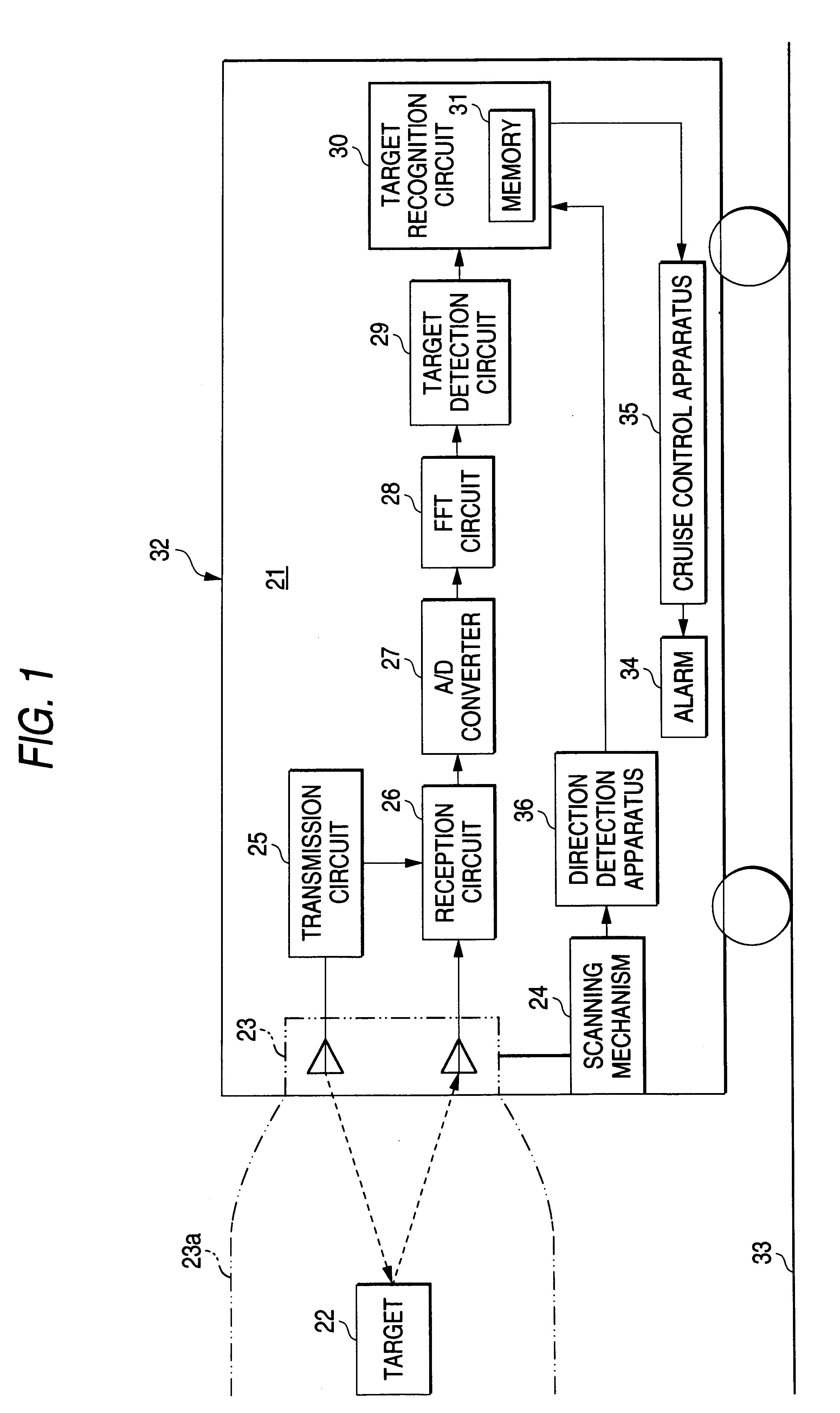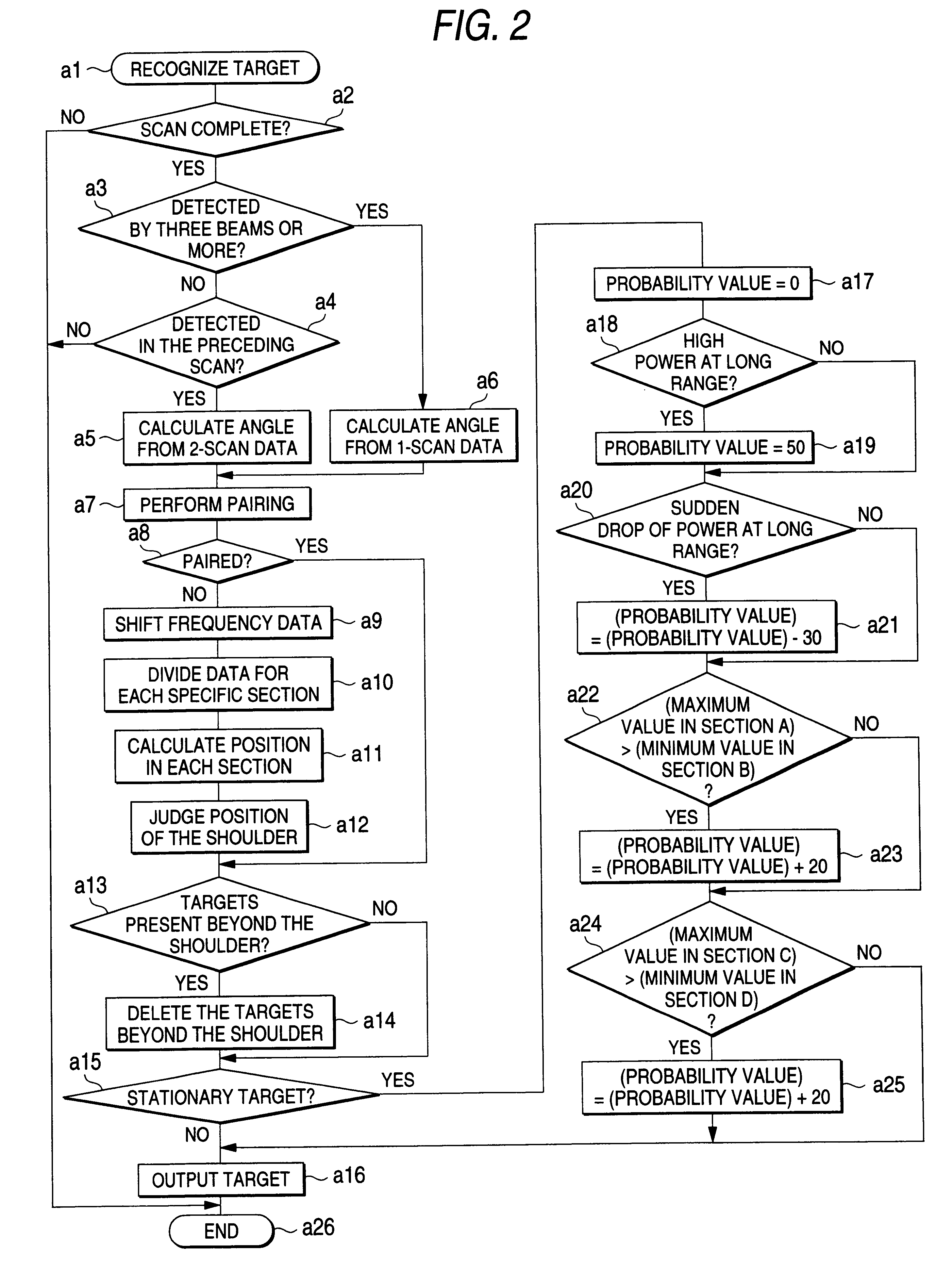Motor-vehicle-mounted radar apparatus
a radar and motor vehicle technology, applied in the direction of instruments, using reradiation, transportation and packaging, etc., can solve the problems of high processing load, heat as well as cost, high etc., and achieve the effect of reducing the cost of high-speed signal processing
- Summary
- Abstract
- Description
- Claims
- Application Information
AI Technical Summary
Problems solved by technology
Method used
Image
Examples
first embodiment
FIG. 2 shows the processing procedure of the object recognition circuit 30 as the invention. When a target is recognized, the procedure from step a1 starts. In step a2, it is determined whether or not a single scan of the antenna 23 by the scanning mechanism 24 is complete. In case it is determined that the scan is complete, it is determined whether or not a reflected signal from the target 22 is detected via at least three beams of the antenna 23 with a beam direction 23a facing a single direction while sending an exploration signal in step a3. In case it is determined that the reflected signal is not detected via at least three beams, it is determined whether or not the target recognized in the preceding scan is detected in step a4. In case the target is not detected, execution returns to step a2. In case it is determined that the target 22 detected in the preceding scan is recognized, the beam angle is calculated from the preceding and current scan data in step a5. In case it is ...
third embodiment
FIG. 5 shows the procedure for estimating the position of the target 22 and the relative velocity in case the vehicle 32 approaches the target 22 at a high speed, as the invention. After the target is recognized in step b1, it is determined whether or not the range is shorter than the reference range in step b2. In case it is determined that the range is shorter than the reference range, it is determined whether or not the relative velocity is higher than the reference velocity. In case it is determined that the range is not smaller than the reference range in step b2, or in case it is determined that the relative velocity is not higher than the reference velocity in step b3, the range and the relative velocity to the target 22 are calculated using the data in the frequency rise section and the frequency drop section in step b4, same as the typical FM-CW system. In case it is determined that the relative velocity is higher than the reference velocity in step b3, data in the frequenc...
fourth embodiment
FIG. 7 shows an example of a philosophy that determines whether or not a stationary object on the road can be cleared in an approach to the object as the invention. When a target 42 where an exploration signal 40 transmitted from an antenna 23 of the vehicle 32 reflects to become a reflected signal 41 is relatively higher than the road surface 43, a multipath error takes place. The reflected signal 41 is either a signal directly received by the antenna 23 or a signal reflected off a road surface 43 and received by the antenna 23. This causes a phase difference between reflected signals 41 that are received based on the path difference. When the reflected signals 41 cancel each other due to this phase difference, the reflected signal level drops.
FIGS. 8A and 8B show a difference of the signal level aused by the height of the target 42 from the road surface 43 when the signal level of the reflected signal 41 relative to the range is represented as a power. FIG. 8A shows the variation ...
PUM
 Login to View More
Login to View More Abstract
Description
Claims
Application Information
 Login to View More
Login to View More - R&D
- Intellectual Property
- Life Sciences
- Materials
- Tech Scout
- Unparalleled Data Quality
- Higher Quality Content
- 60% Fewer Hallucinations
Browse by: Latest US Patents, China's latest patents, Technical Efficacy Thesaurus, Application Domain, Technology Topic, Popular Technical Reports.
© 2025 PatSnap. All rights reserved.Legal|Privacy policy|Modern Slavery Act Transparency Statement|Sitemap|About US| Contact US: help@patsnap.com



